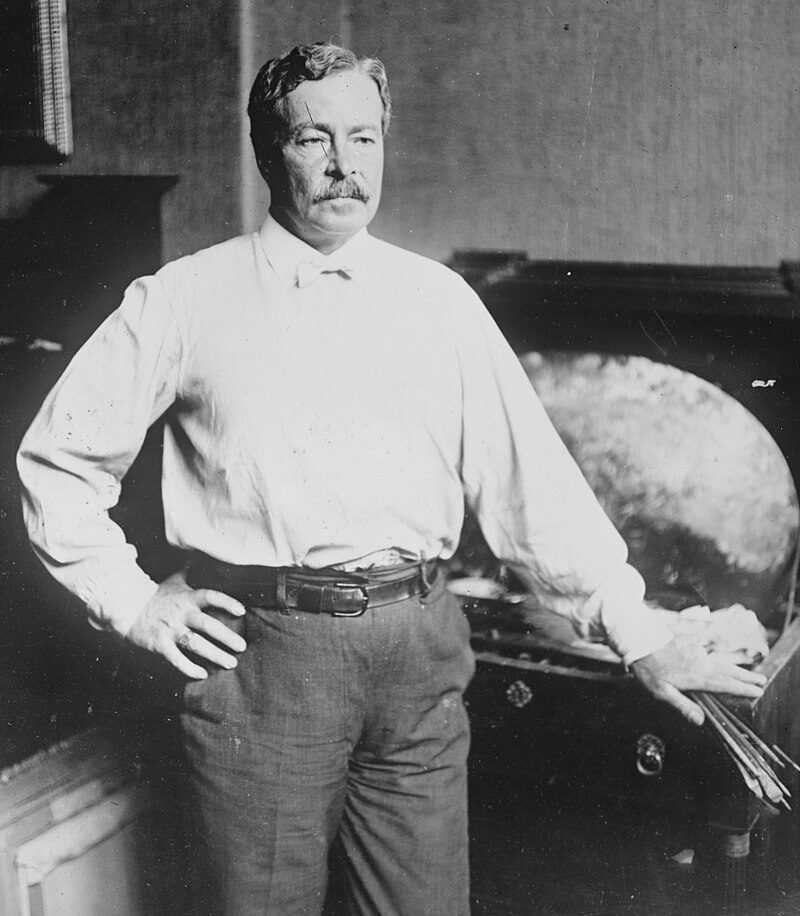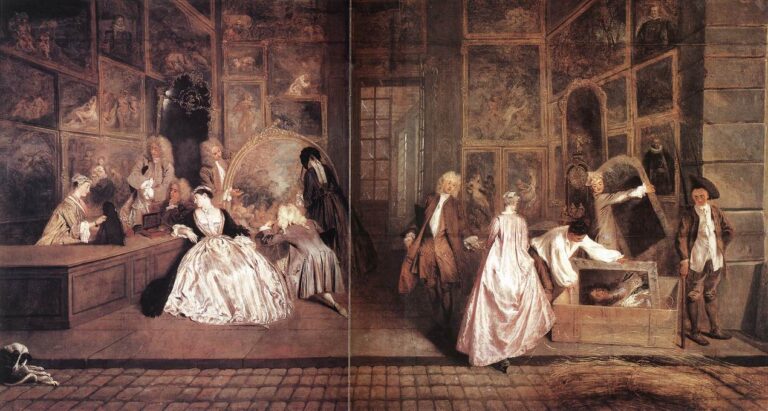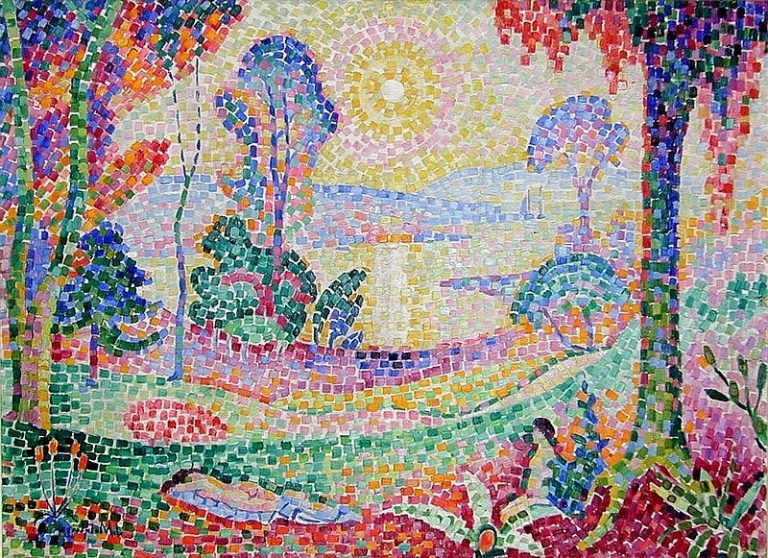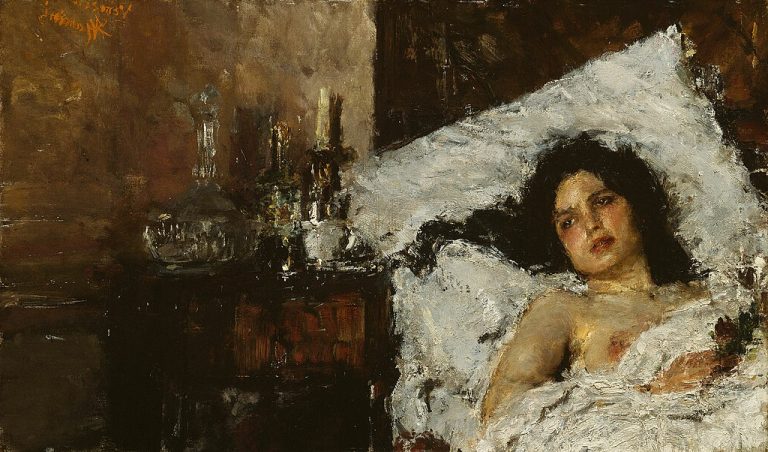Childe Hassam Paintings: Exploring American Impressionism Masterpieces
Born: October 17, 1859, Massachussets, United States
Death: August 27, 1935; New York, United States
Art Movement: Impressionism
Nationality: American
Influenced By: Claude Monet, Georges Seurat, James McNeill Whistler
Institution: Académie Julian, Paris, France and Art Students League of New York, New York City
Childe Hassam Paintings: Exploring American Impressionism Masterpieces
Childe Hassam’s Early Life and Career
Childe Hassam was a major figure in American Impressionism. His early experiences in Boston and exposure to European art shaped his development as an artist.
Birth and Early Influences
Frederick Childe Hassam was born on October 17, 1859, in Dorchester, Massachusetts, a neighborhood of Boston. Growing up in a family with roots tracing back to English settlers, his surroundings greatly influenced his early life. The bustling city of Boston provided young Hassam with a vibrant urban landscape.
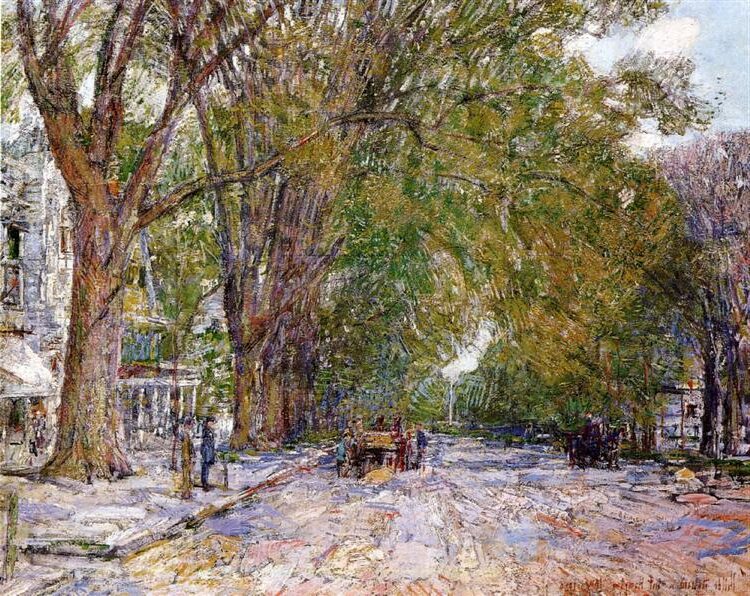
Elms, East Hampton, New York (circa 1920) by Childe Hassam
After his father’s business was lost to a fire, he decided to leave high school. This experience taught him resilience and the importance of hard work. Despite the challenges faced, his New England heritage played a crucial role in inspiring his future artistic pursuits.
Initial Artistic Endeavors
Hassam’s initial journey into art began with wood engraving, a skill he learned to support his family. As a teenager, he created illustrations for local newspapers in Boston. His eye for detail helped him capture lively scenes of urban life.
In his early 20s, he transitioned from engraving to painting. Hassam enrolled at the Lowell Institute, where he honed his skills. He also joined the Boston Art Club, where his works were noticed and appreciated. His early paintings often depicted scenes of New England life, reflecting his deep connection with his birthplace.
Development as an Impressionist
Hassam’s exposure to European Impressionism significantly influenced his development as an artist. In 1883, he traveled to Paris, immersing himself in the art scene. Absorbing the techniques of French Impressionists, he began to incorporate their approach.
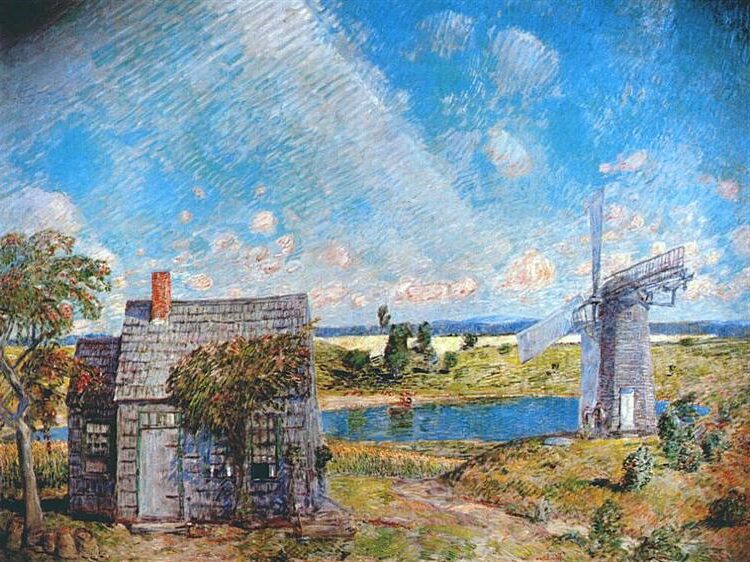
Old Long Island Landscape (1920) by Childe Hassam
This influence is evident in his use of light and color. Returning to the US, Hassam became a leading figure in American Impressionism. His paintings started to capture urban and coastal scenes with vibrant colors and dynamic compositions. His works were instrumental in popularizing Impressionism among American collectors and museums.
Hassam’s Impressionist Technique and Style
Childe Hassam was a pivotal figure in American Impressionism, recognized for his urban and coastal scenes. His technique and style highlight a deep commitment to capturing contemporary life and the transient effects of light and atmosphere.
Adoption of Impressionism
Hassam embraced Impressionism after studying in Paris in the late 19th century. He was influenced by French Impressionists, yet developed a unique style that resonated with American themes. His approach was rooted in capturing real life moments, emphasizing the immediacy of the scene.

Amagansett, Long Island (1920) by Childe Hassam
He avoided the formality of academic painting, favoring spontaneous brushwork. By doing so, he successfully introduced American audiences to an art style that prioritized modernity and liveliness.
Outdoor Studies and Light
Outdoor painting was crucial to Hassam’s works, investing in natural light and weather conditions. He often painted “en plein air” to capture the fluctuating effects of light. Scenes of city streets in the rain or the shimmering sun on coastal shores were common subjects.
His attention to the subtleties of natural phenomena set his work apart. Hassam showed how light varied throughout the day, bringing a fresh perspective to American Impressionist art.
Use of Color and Brushwork
Hassam’s use of color was both vivid and subtle, employing a palette that conveyed the emotion of the scene. His color choices often included muted tones. These colors, mixed with bright accents, provided both energy and harmony to his paintings.
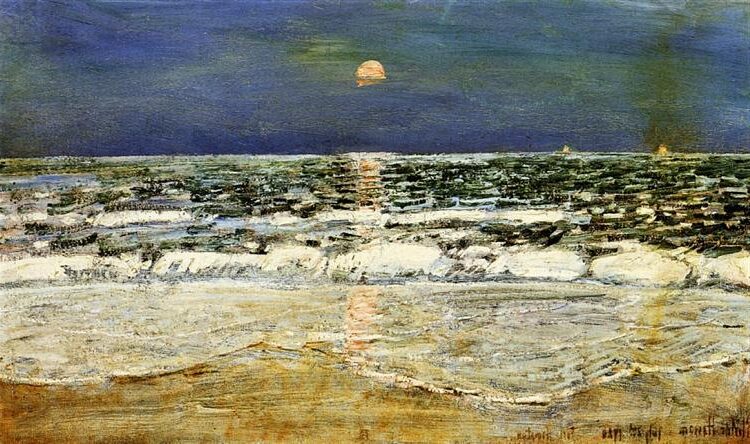
East Hampton (1920) by Childe Hassam
Brushwork played a fundamental role in his technique. Hassam applied paint with short, broken strokes, which created a sense of movement and depth. This method allowed him to depict a scene with energy and immediacy. His watercolor work also demonstrated this fluidity, using light washes to achieve transparency and nuance.
Major Works and Series
Childe Hassam’s paintings are celebrated for their vibrant and atmospheric qualities. His series often capture notable locations or events, providing a window into American life through his Impressionist lens.
Isles of Shoals Paintings
The Isles of Shoals, located off the coast of Maine and New Hampshire, served as a frequent subject for Childe Hassam. He often stayed on Appledore Island, where poet Celia Thaxter hosted many artists and writers.

Coast Scene, Isles of Shoals (1901) by Childe Hassam
Hassam’s work from this period reflects the serene beauty of the region. His paintings capture the sunlit landscapes and rich coastal scenes. The shimmering light on water and lush gardens became hallmarks of his Isles of Shoals series. This collection remains significant in showcasing his distinctive impressionistic style and love for nature.
Fifth Avenue Series
Hassam’s Fifth Avenue Series features bustling scenes from New York City, reflecting its urban energy. Created during a time of rapid change, the series captures the patriotic fervor during World War I.
Fifth Avenue, adorned with American flags, becomes alive through Hassam’s brushwork. Paintings like “The Avenue in the Rain” depict vibrant city life under the waving flags. The series is essential in understanding Hassam’s ability to blend urban subjects with a strong sense of national pride.
World War I Related Works
Hassam produced a series of paintings during World War I that express his support for the Allied cause. This includes some of his well-known flag paintings, where American flags dominate busy cityscapes.
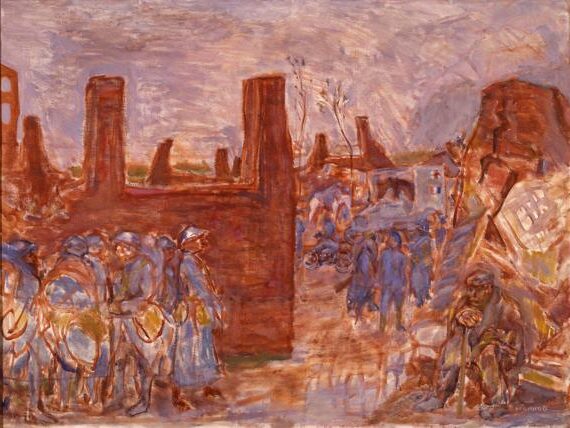
A Village in Ruins Near Ham (1917)
These works, often set against the backdrop of Fifth Avenue, symbolize unity and patriotism. Works like “Boston Common at Twilight” illustrate how Hassam infused his art with a sense of hope and resilience. This focus on national themes added depth to his oeuvre during a significant historical period.
Influence and Legacy
Childe Hassam played a pivotal role in shaping American Impressionism through his unique use of light and color. His work remains celebrated in major art institutions worldwide, highlighting the lasting impact of his creative journey.
Contributions to American Impressionism
Childe Hassam was a key figure in introducing Impressionism to America. He was part of the group known as the Ten American Painters, which aimed to promote this style in the U.S. Hassam’s canvases often depicted urban and coastal scenes, vividly capturing light and atmosphere.

The House of Actaeon, Montauk (1921) by Childe Hassam
Hassam’s work influenced many American artists of his time and enriched the American Impressionist movement. His ability to evoke mood and place through dynamic brushwork and vibrant color was noteworthy.
Legacy in Art Institutions
Hassam’s legacy continues through his artwork displayed in prestigious galleries. His pieces are housed at the Metropolitan Museum of Art, the Museum of Fine Arts, and the Smithsonian American Art Museum.
His contributions are prominently featured at the National Gallery of Art. These institutions recognize his work’s significance, ensuring new generations appreciate and study his influence in art history.
Hassam’s paintings remain popular in exhibitions, underlining his enduring impact. These displays speak to the artist’s ability to capture both ordinary and transformative moments, leaving a lasting impression across iconic art venues.
Collections and Exhibitions
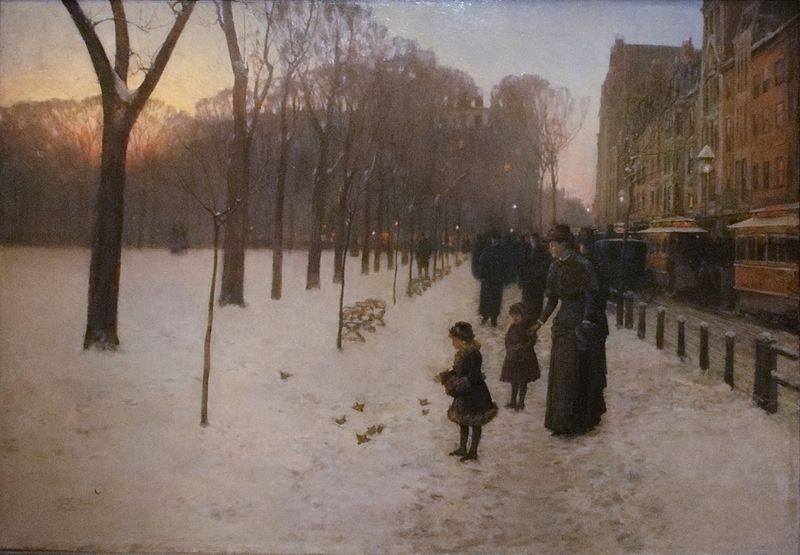
Boston Common at Twilight (1885) by Childe Hassam
Childe Hassam’s work has been displayed in many renowned locations and exhibits. These exhibitions and collections allow audiences to appreciate his impressionist style and coastal landscapes, reflecting his influence on American art.
Prominent Exhibitions
Childe Hassam has been featured in several prestigious exhibitions. The Metropolitan Museum of Art and the National Gallery of Art have hosted exhibitions showcasing his work. His pieces often appear in solo exhibitions, highlighting his ability to capture the beauty of everyday scenes.
The Pennsylvania Academy of the Fine Arts has also provided a platform for Hassam’s work, reflecting his important place in American Impressionism. Each exhibition emphasizes Hassam’s vivid brushwork and ability to depict light, showcasing why his pieces remain influential in art history.
Hassam in Art Museums
Several art museums hold Childe Hassam’s work in their permanent collections. The Smithsonian American Art Museum has a remarkable collection that spans his career. Visitors can see the progression of his style and themes over time.
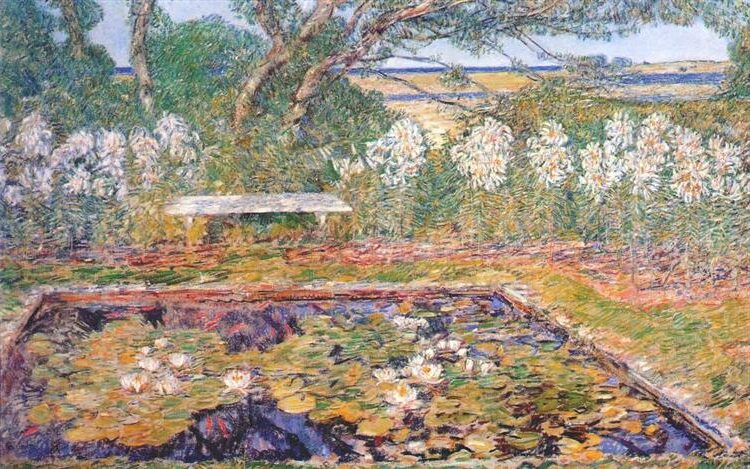
Amagansett, Long IslaA Long Island Garden (1922) by Childe Hassamnd (1920) by Childe Hassam
The Museum of Fine Arts houses several of Hassam’s paintings, offering a glimpse into his exploration of urban and rural landscapes. Additionally, solo exhibitions allow his work to be viewed as part of broader narratives, conveying the richness and diversity of his artistic contributions.
Frequently Asked Questions
Childe Hassam was a key figure in American Impressionism, known for his vibrant urban and coastal scenes. His works are displayed in prominent museums, and his style and contributions to art are notable.
What techniques characterized Childe Hassam’s approach to American Impressionism?
Childe Hassam was famous for using loose brushwork and bright colors. He often painted en plein air, capturing natural light and atmosphere in his work. His technique was similar to that of French Impressionists, but he also brought his own unique perspective, focusing on urban and coastal themes.
Where can one find Childe Hassam’s artworks on display?
Hassam’s artworks can be found in various prestigious institutions, including the Metropolitan Museum of Art and the Museum of Fine Arts, Boston. Many of his pieces also reside in private collections around the world, making them accessible through exhibitions.
What are some of the most notable works by Childe Hassam?
Notable works by Childe Hassam include “The Avenue in the Rain,” “The White Dory,” and his famous “Flags” series. These pieces highlight his talent for capturing light and emotion, depicting scenes that evoke a sense of place and time.
What role did Childe Hassam play in the development of American Impressionism?
Hassam played a pivotal role in American Impressionism by bringing the techniques of European Impressionists to the American art scene. His work helped popularize the movement in the United States and influenced many artists who followed him.
How does Childe Hassam’s work compare to that of other American Impressionists?
Hassam’s work stands out due to his focus on urban landscapes and vibrant depictions of city life. While other American Impressionists also drew inspiration from Europe, Hassam’s unique perspective and prolific output set him apart, with over 3,000 works to his name.
What themes and subjects are commonly depicted in Childe Hassam’s paintings?
Hassam frequently painted urban and coastal scenes. Themes of American life and patriotism are evident in his work. His “Flags” series, for instance, showcases his interest in national identity. Meanwhile, his coastal scenes reflect his love for the natural environment.


